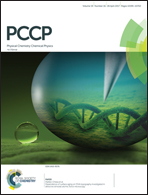A theoretical insight into the formation mechanisms of C/N-ribonucleosides with pyrimidine and ribose†
Abstract
The detailed formation mechanisms of C-ribonucleoside and N-ribonucleoside via the reaction of 2,4,6-triaminopyrimidine (TAP) with (D)-ribose in aqueous solution were explored using density functional theory (DFT). The calculations indicate that five isomers (α,β-furanose, α,β-pyranose and open-chain aldehyde) of (D)-ribose can exist in equilibrium in aqueous solution. In contrast to cyclic isomers, an open-chain aldehyde is most feasible to react with TAP. In general, the formation pathways of C-nucleoside and N-nucleoside proceed in three steps including nucleophilic addition, dehydration and cyclization. The calculated apparent activation energies are 28.8 kcal mol−1 and 29.2 kcal mol−1, respectively. It suggests that both C- and N-nucleoside can be formed in aqueous solution, which is in good agreement with the experimental results. The water molecule plays an important “H-bridge” role by the hydrogen atom relay. Finally, a model structure of nucleobase, which will be beneficial for the C–C glycosidic bond formation, is proposed.



 Please wait while we load your content...
Please wait while we load your content...